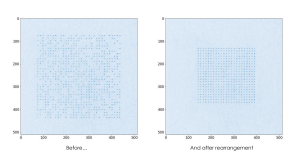Authors: Constantin Dalyac, Alexandre Dauphin
Human progress has always hinged on the stuff we make things from. Bronze forged empires, steel built the modern world, and silicon wired us into the digital age. As our technology has evolved, so has our precision: we’ve gone from casting metal to sculpting matter, shrinking down until we can now produce materials that are literally one atom thick. This unprecedented ability to control and engineer quantum materials with the desired properties is at the heart of the second quantum revolution and opens new avenues for industries such as energy, manufacturing, and sustainable technology development.
Quantum Frontiers in ultrathin materials
In particular, two-dimensional quantum materials, first popularized by graphene, reveal a playground of quantum phenomena: ultra-fast electrons, switchable magnetism, and strong light–matter interactions. Because these materials are only a few atoms thick with extremely clean surfaces, they reduce many of the problems that bulk materials face—such as cracks, impurities, and structural defects that weaken performance and cause inconsistency. Researchers believe these atomically thin marvels will transform many domains, from ultraefficient electronics and next generation‑ energy storage to flexible bio-sensors.
Yet designing such materials and exploring their properties is no trivial task. Quantum effects largely dominate at the atomic scale and classical computation quickly becomes impractical: predicting properties require amounts of memory and computation time that increase exponentially with the number of atoms in the sheet. To overcome the computational challenges, scientists developed approximation methods, like density functional theory (DFT), which has been very useful for understanding the properties of bulk materials by simplifying the complex interactions between electrons. However, for ultra-thin two-dimensional materials, DFT can struggle because of intricate quantum effects like strong electron interactions and sensitive magnetic behaviours. As a result, new and more precise tools are needed to fully capture the unique behaviour of these atom-thin materials.
Quantum Simulators: Microscope-Like Tools Transforming Material Science
Back in the 1980s, Richard Feynman proposed the idea of quantum simulation — using one quantum system that we control very well to mimic another. Instead of trying to solve extremely complex equations on a regular computer, scientists build special quantum systems that behave just like the material they want to study—kind of like using a wind tunnel to test how air flows over a plane. This concept became a reality thanks to the advances in neutral-atom platforms. In these systems, individual atoms are trapped and arranged in reconfigurable two-dimensional arrays, where their interactions can be finely tuned. By carefully controlling how these atoms interact with lasers, they can observe quantum behaviours—like magnetism and exotic states—happen one atom at a time. In fact, in a landmark experiment [P. Scholl et al, Nature 595, 233 (2021)], the laboratory of Antoine Browaeys and Thierry Lahaye was able to engineer a 2D quantum magnet and study the appearance of the celebrated antiferromagnetic phase, where the spins are anti aligned.
Pasqal’s Neutral Atom Quantum Processors for Quantum Materials Discovery
At Pasqal, we are harnessing neutral-atom quantum processors to explore the physics of quantum materials. Our teams have developed hybrid quantum–classical algorithms to model strongly correlated electrons — systems where conventional methods often fail. We have also used these processors to simulate exotic quasiparticles known as mesons, which mirror phenomena seen both in high-energy physics and in condensed matter systems such as CoNb2O6 – part of the Cobalt Niobate materials family well explored for its potential applications in microwave devices and photocatalysts operating at room temperature. Crucially, these algorithms run directly on our cloud platform, enabling experiments that are not only powerful but reproducible — a cornerstone of scientific progress . Step by step, we’re moving toward a future where scientists can study and design quantum materials using quantum computers themselves. Guided by the rigorous quantum advantage framework developed with IBM, we now have clear criteria showing that simulations involving more than 250 qubits we can target regimes beyond classical capabilities—bringing practical and verifiable quantum advantage in materials simulation within sight.


